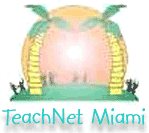|
How It Works:
This unit is an integrated curriculum that incorporates skills in
mathematics, information literacy skills and technology.
Students will develop visual imagination to understand geometrical
concepts. Through the lessons in
this unit, the students will develop spatial sense, use shape as an analytics
and descriptive tool, identify characteristics and define shapes.
The world around us is filled with geometric figures and shapes.
It is important for students to locate shapes within their
surroundings, while they begin to ask questions without realizing they are
“talking mathematics”. This
unit allows students to feel and discover the basic geometric shapes found all
around us.
Standards:
The students will identify and describe objects in his/her environment
that depict plane geometric figures (triangle, rectangle, square, and circle).
The student will identify, describe, and sort three-dimensional (solid)
concrete figures, including cube, rectangular solid (prism), square pyramid,
sphere, cylinder, and cone, according to the number and shape of the solid’s
faces, edges, and corners.
The student will identify and create figures, symmetric along a line, using
various materials.
The student will identify “unit cell” among patterns.
The student, given appropriate drawings and models, will identify and describe
congruent and symmetrical, two and three-dimensional figures.
The student will recognize the images and figures resulting from geometric
shapes.
Estimated Class Periods To Complete:
10 or more
Software Materials Used:
Mathematical Concepts – Geometry video by Schlessinger #K8556
Internet.
Software to complete multimedia presentation such as PowerPoint, Hyperstudio
or Kidpix
Word Processing software.
Various fiction and non-fiction books.
Keywords:
Geometry, Square, Circle, Triangle, Rectangle, Prism, Cone, Cube, Pyramid,
Cylinder, Sphere, Dimensional, Pattern, Unit Cell, Symmetry, Translation,
Plane, Reflection.
Students:
This project is suitable for intermediate grades in Elementary School.
Activities may need to be adapted to meet the needs of the students in
your classroom. The lessons
provided support a variety of learning activities, which can be done
individually, or in collaborative groups.
Students need will need basic skills in reading and writing as well as
technology.
Overall:
The intent of this project is to teach geometric perception. These lessons
are structured to facilitate the student’s discovery of the concept through
a series of teacher-guided constructivist activities that draw upon the
student’s real-world experience. Students
are encouraged to formulate definitions of geometric shapes, dimensions,
patterns and symmetry of real objects provided by the teacher.
They participate in multimedia activities, and applying their knowledge
to real-world settings. All of
these activities take place through a collaborative effort, as students work
in groups. This allows students to learn from each other through the exchange
of ideas and knowledge. It also enhances and promotes communication skills,
since students learn to convey their ideas clearly and effectively.
Tips:
Have all printable worksheets ready for students.
Check all the internet links prior to beginning unit.
Read titles that will be read aloud to the students, view video prior
to showing to the class and check FOSS kit to make sure it has all the
materials. Make sure all students are computer literate and can independently
navigate through the internet. A
mini-lesson on the multimedia software such as PowerPoint would be necessary
for students who are first time users. Share
and explain all rubrics used to assess student work.
|
About the Teacher:
Miriam Gomez has been teaching in the Miami-Dade Public Schools System for
12 years. She is a certified
Library Media Specialist. Ms.
Gomez received her Bachelor’s and Master’s Degree from
Nova
Southeastern
University
. She taught 2nd grade
for 3 years and has been the Media Specialist at her school for the past nine
years. She provides information
literacy skills and computer training to students.
She taught an afternoon Advance Academic Excellence Program for 7 years
at her school. As an active
participant of Citibank Family/Tech program, Miriam provides opportunities for
all the students in her school to be involved in technology projects as part
of the school’s information literacy curriculum.
Subjects:
Math
Grade Levels:
3-5
Email Miriam
|

